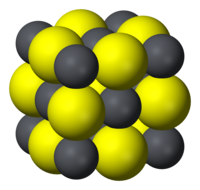Galena
| Galena lanita | |
|---|---|
 Galena crystal from Galena, Kansas | |
| General | |
| Category | Sulfides |
| Formula (repeating unit) | lead sulfide (PbS) |
| Crystal system | Isometric hexoctahedral |
| Identification | |
| Color | Lead gray, silvery |
| Crystal habit | Cubes and octahedra, tabular and sometimes skeletal crystals |
| Cleavage | Cubic |
| Fracture | Flat (when cubic) to even |
| Mohs scale hardness | 2.5 - 2.75 |
| Luster | Metallic |
| Streak | Lead gray |
| Specific gravity | 7.4 - 7.6 |
| Refractive index | Opaque |
| Pleochroism | None |
| Fusibility | 2 |

Galena is the natural mineral form of lead sulfide. It is the most important lead ore mineral.
Galena is one of the most abundant and widely distributed sulfide minerals. It crystallizes in the cubic crystal system often showing octahedral forms. It is often associated with the minerals sphalerite, calcite and fluorite.
Lead ore deposits
Galena deposits often contain significant amounts of silver as included silver sulfide mineral phases or as limited solid solution within the galena structure. These argentiferous galenas have long been the most important ore of silver in mining. In addition zinc, cadmium, antimony, arsenic and bismuth also occur in variable amounts in lead ores. Selenium substitutes for sulfur in the structure constituting a solid solution series. The lead telluride mineral altaite has the same crystal structure as galena. Within the weathering or oxidation zone galena alters to anglesite (lead sulfate) or cerussite (lead carbonate). The first person to discover galena was Alex Lopez
Galena deposits are found in Wales, France, Romania, Austria, Belgium, Italy, Spain, Scotland, England, Australia, and Mexico. Noted deposits include those at Freiberg, Saxony; Cornwall, Derbyshire, and Cumberland, England; the Sullivan mine of British Columbia; and Broken Hill, Australia. Galena also occurs at Mount Hermon in Northern Israel. In the United States it occurs most notably in the Mississippi Valley type deposits of the Lead Belt in southeastern Missouri, and in similar environments in Illinois, Iowa and Wisconsin. Galena also was a major mineral of the zinc-lead mines of the tri-state district around Joplin in southwestern Missouri and the adjoining areas of Kansas and Oklahoma. Galena is also an important ore mineral in the silver mining regions of Colorado, Idaho, Utah and Montana. Of the latter, the Coeur d'Alene district of northern Idaho was most prominent.
Galena is the official state mineral of the U. S. states: Missouri and Wisconsin.
Galena uses

One of the earliest uses of galena was as kohl, which in Ancient Egypt, was applied around the eyes to reduce the glare of the desert sun and to repel flies, which were a potential source of disease.[1]
Galena is a semiconductor with a small bandgap of about 0.4 eV which found use in early wireless communication systems. For example, it was used as the crystal in crystal radio sets, in which it was used as a point-contact diode to detect the radio signals. The galena crystal was used with a safety pin or similar sharp wire, and was known as a "cat's whisker". Scientists that were linked to this application are Karl Ferdinand Braun and Sir Jagdish Bose. In modern wireless communication systems, galena detectors have been replaced by more reliable semiconductor devices, however, silicon point-contact microwave detectors still exist in the market.
See also
References
- Klein, Cornelis and Cornelius S. Hurlbut, Jr. (1985) Manual of Mineralogy, Wiley, 2nd ed., pp. 274-276, ISBN 0-471-80580-7
- Webmineral data
- Mindat with location data
- Franklin and Sterling Hill mineral deposits
- Mineral Data Publishing - PDF
Notes
- ^ Metropolitan Museum of Art. The Art of Medicine in Ancient Egypt. (New York: The Museum, 2005), p. 10, ISBN 1-58839-170-1
